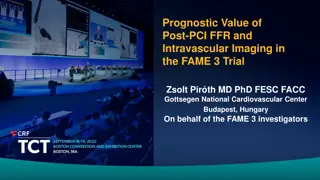Understanding PCI/PCIe Expansion ROMs in x86 Systems
Explore the internals of PCI/PCIe Expansion ROMs (XROMs) in x86 systems, examining their role as executable code located on PCI devices, handling by BIOS during boot, configuration via Expansion ROM Base Address Register, and differences on legacy versus modern systems.
Download Presentation

Please find below an Image/Link to download the presentation.
The content on the website is provided AS IS for your information and personal use only. It may not be sold, licensed, or shared on other websites without obtaining consent from the author. Download presentation by click this link. If you encounter any issues during the download, it is possible that the publisher has removed the file from their server.
E N D
Presentation Transcript
Advanced x86: BIOS and System Management Mode Internals PCI {Option/Expansion} ROMs Xeno Kovah && Corey Kallenberg LegbaCore, LLC
All materials are licensed under a Creative Commons Share Alike license. http://creativecommons.org/licenses/by-sa/3.0/ Attribution condition: You must indicate that derivative work "Is derived from John Butterworth & Xeno Kovah s Advanced Intel x86: BIOS and SMM class posted at http://opensecuritytraining.info/IntroBIOS.html 2
TWO SIGMA Thunderstrike 2: Sith Strike Trammell Hudson Two Sigma Xeno Kovah, Corey Kallenberg LebgaCore 6
PCI/PCIe Expansion ROMs (XROMs) aka Option ROMs (OROMs) A PCI/PCIe Expansion ROM is x86 native executable code located on a PCI device Can technically have multiple architectures native code on it, so that the device can load just as well on a PPC device as an x86 one. Not every device will have one Graphics cards, network cards will likely have one A device can have multiple XROMs (for multiple architectures) Benign or otherwise this code gets executed by the CPU/BIOS during the boot process They are handled the same on PCI Express as they are in PCI They are configured via a separate BAR called the Expansion ROM Base Address Register 7
Expansion ROMs XROMs have their own BAR called the Expansion ROM Base Address Register On general type PCI devices it s located at offset 30h On bridge type devices it s at 38h BIOS initializes the XROM BAR like the other BARs, but hands off execution control to the code it points to XROMs are copied to memory before being executed On legacy systems they are copied to C0000 to DFFFFh range The XROM BAR operates similarly to the other BARs but the interpretation of the field s bits is slightly different 8
Expansion ROM Base Address Register The LSB determines whether accesses to the Expansion ROM are permitted. When asserted to 1, they are permitted Even when a device has an Expansion ROM, its BAR may still be 0 (meaning access to it is not permitted) Like the PCI BARs, the Expansion ROM BAR is also R/W 9
Command Register and Address Space Access 1 An expansion ROM will only respond to accesses if the Expansion ROM Enable bit and the memory space bit in the Command Register are both set 1 10
How CPU/BIOS Discovers XROMs 0 1111 1111 1111 1111 1111 1 Expansion ROM Base Address Register CPU/BIOS writes FFFF_F800h To determine whether the device has implemented an Expansion ROM base: All 1 s are written to the top 21 bits (31:11) of the Expansion ROM BAR If the device returns anything other than 0, then it has implemented an Expansion ROM 11
How CPU/BIOS Discovers XROMs 0 1111 1111 1111 1110 0000 0 Expansion ROM Base Address Register Device returns FFFE_0000h The return address indicates both the size of the ROM and the memory alignment (mask) required by the ROM: Per the above example: Size = ~FFFE_0000 +1 = 2_0000h bytes ROM must be mapped to a 128KB-aligned memory address So addresses like XXX00000, XXX20000, XXX40000, etc 12
How CPU/BIOS Discovers XROMs 1 ( Some memory address ) Expansion ROM Base Address Register CPU/BIOS maps the ROM and enables it Next the CPU/BIOS maps the ROM to an unused portion of memory Then it sets the enable bit so that the ROM is now accessible at the address defined by the BIOS 13
How CPU/BIOS Discovers XROMs CPU/BIOS checks memory for Option ROM structure If anything other than the AA55 signature is present, there is actually no Option ROM provided by the device, despite the fact that it returns a mask as if there were I have some ice cream. Want a lick? Psych! There may still be an option ROM, however, some companies implement them in non-standard ways PCI Express Revision 3.0 14
CPU/BIOS Expansion ROM Discovery A PCI device can share a decoder between the Expansion ROM BAR and other BARs For example: Some vendors mirror their Expansion ROMs at BAR[n] or at an offset from BAR[n] NVidia sometimes puts them at BAR[0] + 30_0000h (per the developers of Flashrom ) http://flashrom.org/Flashrom It is possible that there simply is no Expansion ROM present on the device Could be located in a compressed module in the BIOS binary 15
Expansion ROM Discovery: User Example (Same as BIOS) This example pertains to the nVidia VGA card on the E6400 laptop Verify that the memory-enable space bit 1 in the command register (offset 04h) is asserted Writing FFFF_F800h to offset 30h returns FFFE_0000h indicating that an Expansion ROM [might be] present Bit 17 is the LSB, which indicates a 128KB ROM Size = ~FFFE_0000 + 1 = 2_0000h bytes 16
Expansion ROM Discovery: User Example (Same as BIOS) 00100001 We (or the BIOS) should be able to choose a memory address for the ROM to be mapped to Address must meet alignment requirements Address must provide enough room for the XROM Must enable the XROM decoding (assert bit 0, enable) 17
Expansion ROM Discovery: User Example (Same as BIOS) 00100001 If there is anything other than the AA55 XROM signature, then there is actually no option ROM present As it turns out, in this case, there is no option ROM located on the device This option ROM is located on the BIOS flash as a compressed module 18
Expansion ROM Hacking Hacking an Expansion ROM typically requires reflashing the firmware on the device Often the RO in ROM is a misnomer Although in the case we just saw, modifying the BIOS itself could permit an attacker to insert a malicious XROM If a vendor offers a utility to update the flash then you know the flash is writeable Good reference on XROM hacking: http://resources.infosecinstitute.com/pci-expansion-rom/ It s important for Option ROMs to be measured (measured boot) before being executed 19
Secure Boot Systems that support UEFI/Windows 8 Secure Boot require XROMs to be signed before it will execute them Assuming you didn t turn off SecureBoot Apple systems don t support SecureBoot, therefore what worked in 2012 still works today The fact that systems load XROMs off external peripherals like the Thunderbolt Ethernet adapter make it just that much easier to attack Macs this way 20
References https://sites.google.com/site/pinczakko/building-a-kernel-in- pci-expansion-rom (Darmawan Salihun) http://www.blackhat.com/presentations/bh-dc- 07/Heasman/Paper/bh-dc-07-Heasman-WP.pdf (John Heasman) http://pacsec.jp/psj13/psj2013-day2_Pierre_pacsec-uefi- pci.pdf (Pierre Chifflier) http://ho.ax/downloads/De_Mysteriis_Dom_Jobsivs_Black_Ha t_Slides.pdf (Snare) https://trmm.net/Thunderstrike (Trammel Hudson) http://legbacore.com/Research_files/ts2-blackhat.pdf (Trammel Hudson, Xeno Kovah, Corey Kallenberg) 21























